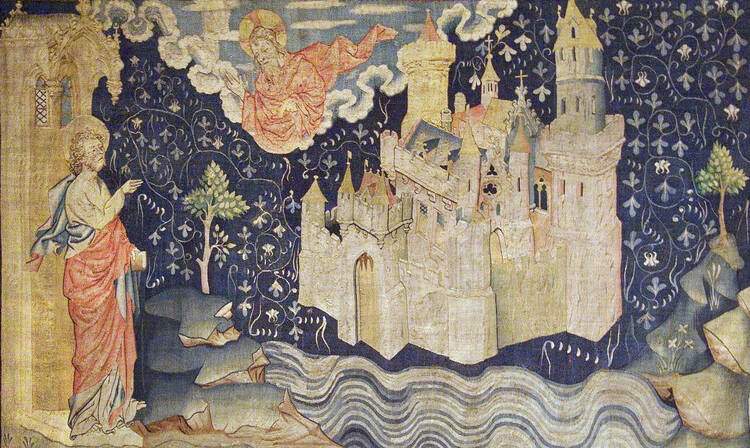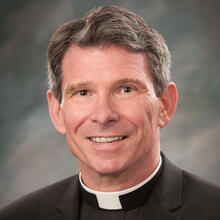A Homily for the Sixth Sunday of Easter
Readings: Acts 15:1-2, 22-29 Revelation 21:10-14, 22-23 John 14:23-29
Have you ever asked a young child to draw a self-portrait? Even if only a stick figure emerges, it will probably not be solitary. No, the child’s family, even the household pets, will be included because children see themselves as part of an enveloping world. To their minds, how could their stick figure be distinguished from another if the people who share their world—we might even say, who are their world—were not included in the drawing?
Perhaps this is yet another example of children possessing a wisdom that they lose as they grow into adulthood: We belong with others. The word individual is a rallying cry for modern men and women, but try explaining its meaning to a small child.
The operative, if subconscious, picture that we adults carry of ourselves is something akin to a billiard ball. We bounce off each other—sometimes mildly, sometimes not—but we remain essentially locked within ourselves. We look out upon the world and the other people in it from the window perch we call our bodies. And even our bodies are thought to be something we possess, something we carry around, not something that we are.
We think: “I stand apart from the world, other people, even my own body.” In this shallow understanding of what it means to be human, it makes sense to say things like “My body, my choice” or “This body just isn’t me—not the real me.”
Yet even in societies that incessantly preach that we are sovereign individuals, who only condescend to relate to others, most of us still sense that this is nonsense. The individual is not the measure of all that is. As Shakespeare wrote in “Hamlet”: “There are more things in heaven and earth, Horatio,/ Than are dreamt of in your philosophy.”
An image of sovereign, colliding billiard balls is neither the Christian nor the ancient understanding of what it means to be a human being. Indeed, the word “individual” does not appear in English until the 15th century, when nation states first arose and began to tax their subjects. A nation could only distinguish itself from other nations by identifying its citizens, which is why surnames came into use at the same time. On a tax role, you cannot just be George, son of John. If nothing else, you are now “George Johnson.”
They say that the dying often revert to the consciousness of childhood, that the most common words or phrases spoken just before death are “Mama,” “Mommy,” “I love you” or “I forgive you.” At the end, even the baddest billiard ball on the planet turns relational.
We need a more childlike, relational picture of what it means to be human if we are going to make sense of, and find comfort in, the image of the next world, which is found in the Book of Revelation. We think of heaven as the place to which the dying individual departs, but heaven envisions itself as that splendid spot where sanctified souls are gathered.
The angel took me in spirit to a great, high mountain
and showed me the holy city Jerusalem
coming down out of heaven from God.
It gleamed with the splendor of God.
Its radiance was like that of a precious stone,
like jasper, clear as crystal (Rev 21:10-11).
Something in our psyche still warms to this picture of heaven as a gleaming city. We sense that we were never meant to be alone, to be unloved. We pray, sometimes desperately, that our loved ones go to heaven, and we tell ourselves—and not without reason—that it could not be a heaven worthy of the name if they were not present.
And maybe we are right. Perhaps the most persuasive argument for an empty hell is our essential rootedness in love, our sense that, come the very end, love must triumph.
The church insists that hell is a real possibility, but she leaves open the question of who, if anyone, might be in hell. Hell might indeed be empty, because even the cruelest figures in history had people who loved them, however much merciful, fiery purification might have been needed on the part of God.
Scripture tells us there is still more to see of the life yet to come! The celestial city
had a massive, high wall,
with twelve gates where twelve angels were stationed
and on which names were inscribed,
the names of the twelve tribes of the Israelites (Rev 21:12).
This “high wall” does not exist to hold people out. No, this bulwark is the power and presence of God holding us together. In heaven, the misunderstandings, the rash decisions and the simmering wounds that keep us from one another will be no more. Venerable Bede says that “the Lord himself can be understood to be this great wall that protects the church on every side” (“Explanation of the Apocalypse,” 21:12). Love reigns in heaven; love guards its own; love makes its Jerusalem into an eternal, compact circle.
At the center of this circle stands the ancient lover of souls, the Lamb Shepherd who summons them to himself.
I saw no temple in the city
for its temple is the Lord God almighty and the Lamb.
The city had no need of sun or moon to shine on it,
for the glory of God gave it light,
and its lamp was the Lamb (Rev 21:22-23).
On earth, we must consciously choose to enter the temple, choose to become the church. We must, as our Lord himself told us, come together so that he may be in our midst (Mt 18:20). But in heaven, the Lamb is all! So pervasive is his presence, it can only be described as light itself.
We judge children’s drawings to be quite rudimentary, even crude. And admittedly, they are first attempts. But in showing themselves to be nestled into worlds of love, children show that they understand us more than we do ourselves. Our Lord told us as much when he turned his eyes towards his Father in heaven.
I give praise to you, Father,
Lord of heaven and earth,
for although you have hidden these things from the wise and the learned
you have revealed them to the childlike (Mt 11:25).








